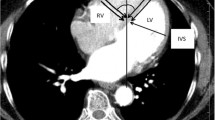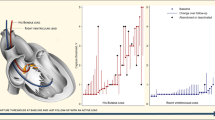Abstract
Background
Conduction system pacing by implanting the lead in the His bundle (HBP) region or in the left bundle branch area (LBBAP) has gained popularity. Myocardial injury current (IC) is useful for predicting adequate lead fixation in right ventricular septal pacing (RVSP).
Objectives and methods
We compared the correlations between IC and lead performance among patients receiving HBP (n = 41), LBBAP (n = 53), and historical RVSP (n = 88). LBBAP was an alternative if optimal HBP was not achieved. A positive IC (STpost-screw-in − STpre-screw-in) was defined as > 0.2 mV or a > 25% ST elevation and prolongation of the ventricular electrograms > 10 ms from baseline.
Results
HBP patients with a positive IC (48%, 0.84 ± 0.4 V/0.4 ms) exhibited a similar pacing threshold to their LBBAP counterparts (76%, 0.75 ± 0.3 V/0.4 ms, p = 0.329), but a higher pacing threshold than their RVSP counterparts (67%, 0.50 ± 0.1 V/0.4 ms, p < 0.001) at implantation. The R-wave (5.70 ± 3.4 mV) and impedance (660.91 ± 140.8 Ω) were both lower than those of LBBAP (10.35 ± 6.0 mV, p = 0.002; 822.36 ± 235.8 Ω, p = 0.005) and RVSP (11.24 ± 4.9 mV, p < 0.001; 754.27 ± 126.4 Ω, p = 0.006) patients respectively at implantation. The trend of electrical parameter comparisons remained unchanged during follow-up (3.56 ± 1.4 months). Notably, HBP patients without ICs had a higher pacing threshold (1.24 ± 0.6 V/0.4 ms) compared to their LBBAP (0.73 ± 0.3 V/0.4 ms, p = 0.009) and RVSP (0.53 ± 0.1 V/0.4 ms, p < 0.001) counterparts at implantation and during follow-up.
Conclusions
The detection of positive changes of myocardial ICs during HBP was associated with a better capture threshold equivalent to the LBBAP counterpart both at implantation and during short-term follow-up. Further large-scale studies with longer follow-up are necessary to confirm these findings.


Similar content being viewed by others
References
Zhang S, Zhou X, Gold MR. Left bundle branch pacing: JACC review topic of the week. J Am Coll Cardiol. 2019;74:3039–49.
Bhatt AG, Musat DL, Milstein N, et al. The efficacy of His bundle pacing: lessons learned from implementation for the first time at an experienced electrophysiology center. JACC Clin Electrophysiol. 2018;4:1397–406.
Vijayaraman P, Dandamudi G, Lustgarten D, et al. Permanent His bundle pacing: electrophysiological and echocardiographic observations from long-term follow-up. Pacing Clin Electrophysiol. 2017;40:883–91.
Huang W, Su L, Wu S. Pacing treatment of atrial fibrillation patients with heart failure: His bundle pacing combined with atrioventricular node ablation. Card Electrophysiol Clin. 2018;10:519–35.
Vijayaraman P, Ellenbogen KA. Approach to permanent His bundle pacing in challenging implants. Heart Rhythm. 2018;15:1428–31.
Kusumoto FM, Schoenfeld MH, Barrett C, et al. 2018 ACC/AHA/HRS guideline on the evaluation and management of patients with bradycardia and cardiac conduction delay: executive summary: a report of the American College of Cardiology/American Heart Association task force on clinical practice guidelines, and the Heart Rhythm Society. Circulation. 2019;140:e333–81.
Sharma PS, Vijayaraman P, Ellenbogen KA. Permanent His bundle pacing: shaping the future of physiological ventricular pacing. Nat Rev Cardiol. 2020;17:22–36.
Padala SK, Master VM, Terricabras M, et al. Initial experience, safety, and feasibility of left bundle branch area pacing: a multicenter prospective study. JACC Clin Electrophysiol. 2020;6:1773–82.
Zhang W, Huang J, Qi Y, et al. Cardiac resynchronization therapy by left bundle branch area pacing in patients with heart failure and left bundle branch block. Heart Rhythm. 2019;16:1783–90.
Saxonhouse SJ, Conti JB, Curtis AB. Current of injury predicts adequate active lead fixation in permanent pacemaker/defibrillation leads. J Am Coll Cardiol. 2005;45:412–7.
Yoshiyama T, Shimeno K, Matsuo M, et al. Efficacy of the current of injury in envisaging the dislodgement of leads implanted in the right atrial septum or the right ventricular septum. Pacing Clin Electrophysiol. 2019;42:603–9.
Vijayaraman P, Dandamudi G, Worsnick S, et al. Acute His-bundle injury current during permanent His-bundle pacing predicts excellent pacing outcomes. Pacing Clin Electrophysiol. 2015;38:540–6.
Su L, Xu T, Cai M, et al. Electrophysiological characteristics and clinical values of left bundle branch current of injury in left bundle branch pacing. J Cardiovasc Electrophysiol. 2020;31:834–42.
Sharma PS, Dandamudi G, Naperkowski A, et al. Permanent His-bundle pacing is feasible, safe, and superior to right ventricular pacing in routine clinical practice. Heart Rhythm. 2015;12:305–12.
Vijayaraman P, Dandamudi G, Zanon F, et al. Permanent His bundle pacing: recommendations from a multicenter His bundle pacing collaborative working group for standardization of definitions, implant measurements, and follow-up. Heart Rhythm. 2018;15:460–8.
Li X, Li H, Ma W, et al. Permanent left bundle branch area pacing for atrioventricular block: feasibility, safety, and acute effect. Heart Rhythm. 2019;16:1766–73.
Kawashima T, Sasaki H. A macroscopic anatomical investigation of atrioventricular bundle locational variation relative to the membranous part of the ventricular septum in elderly human hearts. Surg Radiol Anat. 2005;27:206–13.
Kurosawa H, Becker AE. The conduction bundle at the atrioventricular junction. An anatomical study. Eur J Cardiothorac Surg. 1989;3:283–7.
Kronborg MB, Mortensen PT, Gerdes JC, et al. His and para-His pacing in AV block: feasibility and electrocardiographic findings. J Interv Card Electrophysiol. 2011;31:255–62.
Vijayaraman P, Naperkowski A, Ellenbogen KA, et al. Electrophysiologic insights into site of atrioventricular block: lessons from permanent His bundle pacing. JACC Clin Electrophysiol. 2015;1:571–81.
Deshmukh P, Casavant DA, Romanyshyn M, et al. Permanent, direct His-bundle pacing: a novel approach to cardiac pacing in patients with normal His-Purkinje activation. Circulation. 2000;101:869–77.
Zanon F, Svetlich C, Occhetta E, et al. Safety and performance of a system specifically designed for selective site pacing. Pacing Clin Electrophysiol. 2011;34:339–47.
Elizari MV. The normal variants in the left bundle branch system. J Electrocardiol. 2017;50:389–99.
Funding
This study was supported in part by the Taiwan Ministry of Science and Technology (MOST 111–2314-B-039–012, MOST 110–2314-B-039–050, and MOST 109–2314-B-039–045) and China Medical University Hospital (DMR-111–020 and DMR-110–012). None of these funding sources had a further role in the study design; collection, analysis, or interpretation of data; writing the report; or decision to submit the paper for publication.
Author information
Authors and Affiliations
Contributions
Conceptualization: WH Chung and KC Chang. Methodology: WH Chung, HP Wu, YN Lin, JY Chen, KH Lin, and KC Chang. Formal analysis and investigation: WH Chung, HP Wu, MY Wu, YN Lin, JY Chen, KH Lin, and KC Chang. Writing—original draft preparation: WH Chung and KC Chang. Writing—review and editing: WH Chung, MY Wu, and KC Chang. Funding acquisition: KC Chang. Resources: WH Chung, HP Wu, YN Lin, JY Chen, KH Lin, and KC Chang. Supervision: KC Chang.
Corresponding author
Ethics declarations
Ethics approval
The study protocol was reviewed and approved by the Research Ethics Committee of each center with the joint analysis center at China Medical University Hospital (CMUH110-REC2-114).
Informed consent
Not applicable.
Conflict of interests
The authors declare no competing interests.
Additional information
Publisher's note
Springer Nature remains neutral with regard to jurisdictional claims in published maps and institutional affiliations.
Supplementary information
Below is the link to the electronic supplementary material.
Rights and permissions
Springer Nature or its licensor holds exclusive rights to this article under a publishing agreement with the author(s) or other rightsholder(s); author self-archiving of the accepted manuscript version of this article is solely governed by the terms of such publishing agreement and applicable law.
About this article
Cite this article
Chung, WH., Wu, HP., Wu, MY. et al. Correlations between myocardial injury current and lead performance in His bundle pacing compared with left bundle branch area pacing and right ventricular septum pacing. J Interv Card Electrophysiol 66, 1349–1358 (2023). https://doi.org/10.1007/s10840-022-01385-9
Received:
Accepted:
Published:
Issue Date:
DOI: https://doi.org/10.1007/s10840-022-01385-9




